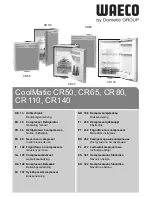
4
3
Ener
gy W
arnings
SAFETY INSTRUCTIONS
SAFETY INSTRUCTIONS
• To avoid contamination of food, please read the following instructions:
• Opening the door for long periods of time can cause a significant
increase in the temperature of the compartments of the appliance.
• Regularly clean surfaces that can come in contact with food and
accessible drainage systems.
• Clean water tanks if they have not been used for 48 hours; flush the
water system connected to a water supply if water has not been drawn
for 5 days.
• Store raw meat and fish in suitable containers in the refrigerator so that
it is not in contact with nor can drip onto other food.
• Two-star frozen food compartments are suitable for storing
pre-frozen food, storing or making ice cream, and making ice cubes.
• One-star , two-star
, and three-star
compartments are not
suitable for the freezing of fresh food.
• If the refrigerating appliance is left empty for long periods, switch off,
defrost, clean, dry, and leave the door open to prevent mold
developing within the appliance.
• The gaps between the doors and between the doors and the refrigerator body
are small. Do not to put your hand in these areas. Be gentle when closing the
refrigerator door to avoid falling articles.
• Do not pick up food or containers with wet hands in the freezing chamber when
the refrigerator is running, especially metal containers, in order to avoid frostbite.
• Do not allow any child to get into or climb the refrigerator to prevent suffocation
or a falling injury.
• Do not place heavy objects on the top of the refrigerator, considering that
objects may fall when closing or opening the door and accidental injuries might
occur.
• Unplug the appliance in the case of power failure or cleaning. Do not connect
the refrigerator to power supply for five minutes to prevent damages to the
compressor due to successive starts.
• Before installation or adjusting the accessories, disconnect the refrigerator from
power.
PLACEMENT OF ITEMS
• Do not put flammable, explosive, volatile and highly corrosive items in the
refrigerator to prevent damage to the product or fire accidents.
• Do not place flammable items near the refrigerator to avoid fires.
• The refrigerator is intended for household use, such as the storage of food; it shall
not be used for other purposes, such as storage of blood, drugs, or biological
products, etc.
• Do not store beer, beverage, or other fluid contained in bottles or enclosed
containers in the freezing chamber of the refrigerator. Otherwise, the bottles or
enclosed containers may crack due to freezing to cause damages.
ENERGY WARNINGS
• Refrigerating appliances might not operate consistently (for example: defrosting
of food or temperature becoming too warm in the frozen food compartment)
when set below the cold end of the range of temperatures for which the
refrigerating appliance is designed for an extended period of time.
• Effervescent drinks should not be stored in food freezer compartments or
cabinets or in low-temperature compartments or cabinets. Some products such
as water ices should not be consumed too cold.
• Do not exceed the storage time(s) recommended by the food manufacturers for
any kind of food and particularly for commercially quick-frozen food in food
freezer and frozen foodstuff storage compartments or cabinets.
• Wrap the frozen food in several layers of newspaper to prevent an undue rise in
the temperature while defrosting the refrigerator.
• A rise in temperature of the frozen food during manual defrosting, maintenance,
or cleaning could shorten the storage life.
Gener
al Safet
y


































